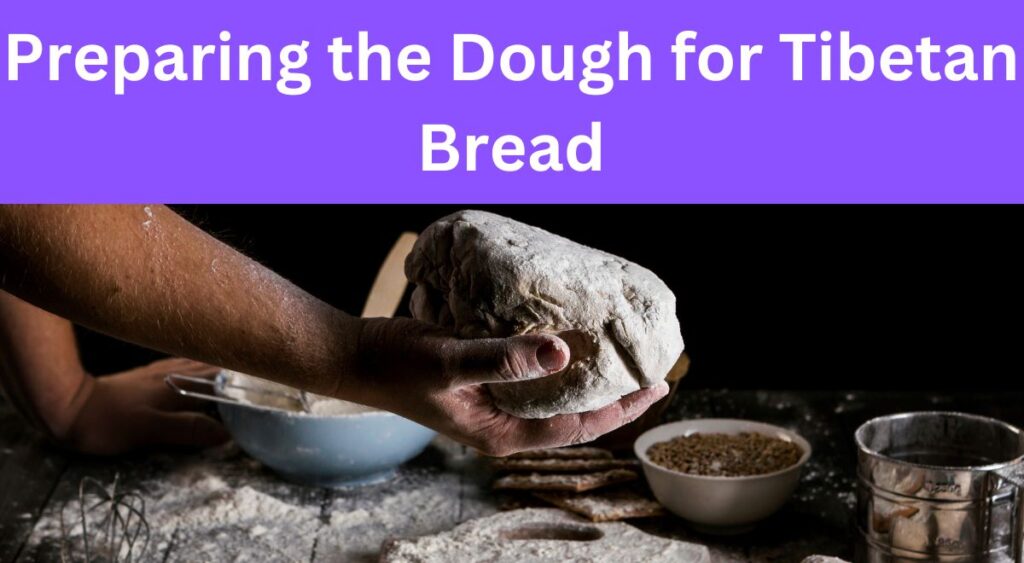Section 1: Introduction: Tibetan Bread Recipe For Weight Loss in 2024
Discover the secret behind Tibetan bread—a centuries-old culinary tradition hailed for its health benefits and unique flavors. In this article, we unveil the art of crafting Tibetan bread, exploring both traditional and modern approaches. From understanding its nutritional value to mastering the preparation techniques, join us on a journey to explore the delights of Balep and how it can be a valuable addition to your weight loss journey.
Section 2: Understanding the Health Benefits
Tibetan bread, known as Balep, offers more than just a delicious taste—it also boasts numerous health benefits that make it an ideal choice for those looking to maintain a balanced diet while aiming for weight loss. Let’s delve into the nutritional aspects that make Tibetan bread a healthy option:

1. Whole Grain Goodness:
Traditional Tibetan bread recipes often use whole grain flour, such as barley or wheat, which provides essential nutrients like fiber, vitamins, and minerals. Whole grains are known for their ability to promote digestive health and regulate blood sugar levels, contributing to weight management.
2. Low in Fat and Sugar:
Compared to many commercially processed bread varieties, authentic Tibetan bread tends to be low in added fats and sugars. This makes it a healthier option for those watching their calorie intake and aiming to reduce excess fat consumption.
3. Rich in Fiber:
Fiber is a crucial component of a weight loss diet as it helps promote satiety, keeping you feeling full for longer periods and reducing the likelihood of overeating. Tibetan bread, especially when made with whole grain flour, is rich in dietary fiber, which aids in digestion and supports a healthy metabolism.
4. Nutrient Density:
Despite its simple ingredients, Tibetan bread packs a punch in terms of nutrients. From essential vitamins like B vitamins and minerals such as iron and magnesium, this bread offers a nutrient-dense option that can help support overall health and well-being.
5. Sustainable Energy:
The complex carbohydrates found in whole grain flour provide a steady release of energy, helping to sustain you throughout the day without the energy crashes associated with refined carbohydrates. This can be particularly beneficial for maintaining energy levels during weight loss efforts, keeping you feeling energized and focused.
In summary, Tibetan bread offers a wholesome and nutritious option for those seeking to incorporate healthier choices into their diet. Its whole grain goodness, low-fat content, fiber-rich nature, and nutrient density make it an excellent addition to a weight loss regimen. By understanding the health benefits of Tibetan bread, you can make informed choices that support your overall well-being while indulging in delicious culinary delights.
Section 3: Traditional Techniques vs. Modern Adaptations
Tibetan bread, with its rich cultural heritage, has been prepared using traditional techniques for generations. However, as culinary practices evolve and dietary preferences change, modern adaptations of Tibetan bread recipes have emerged. Let’s explore the differences between traditional techniques and modern adaptations:
1. Traditional Techniques:
Handcrafted Process:
Historically, Tibetan bread was made by hand, with each step of the process meticulously carried out by skilled artisans. From kneading the dough to shaping and baking, every aspect of bread-making was infused with tradition and cultural significance.
Use of Hearth Ovens:
Traditional Tibetan bread was often baked in hearth ovens, which imparted a distinct flavor and texture to the final product. These ovens, typically made of clay or stone, allowed for even heat distribution, resulting in perfectly baked loaves.
Natural Ingredients:
Traditional Tibetan bread recipes relied on simple, natural ingredients sourced locally. Whole grain flours, water, salt, and sometimes yeast were the primary components, reflecting the availability of ingredients in the region.
2. Modern Adaptations:
Mechanized Production:
With advancements in technology, many modern bakeries have adopted mechanized processes for bread production. This often involves the use of mixers, dough sheeters, and automated ovens to streamline the manufacturing process and increase efficiency.
Variety of Flours:
While traditional Tibetan bread recipes predominantly use barley or wheat flour, modern adaptations may incorporate a wider variety of flours, including gluten-free options like rice flour or almond flour. This allows for greater diversity in flavors and textures to cater to different dietary preferences.
Incorporation of Flavorings:
Modern adaptations of Tibetan bread recipes may also include additional flavorings and ingredients to enhance taste and appeal to contemporary palates. From herbs and spices to dried fruits and nuts, these additions offer a creative twist on traditional recipes.
Cultural Preservation:
Despite modern innovations, efforts are underway to preserve traditional Tibetan bread-making techniques and recipes. Organizations and individuals dedicated to cultural preservation work tirelessly to document and promote traditional culinary practices, ensuring that they are passed down to future generations.
Health Considerations:
In response to growing health consciousness, modern adaptations of Tibetan bread recipes may prioritize healthier ingredients and preparation methods. This includes the use of whole grain flours, reducing or eliminating added sugars and fats, and incorporating functional ingredients known for their health benefits.
In conclusion, while traditional techniques hold a special place in Tibetan culinary heritage, modern adaptations of Tibetan bread recipes offer versatility and innovation. Whether prepared by hand using time-honored methods or produced using modern technology, Tibetan bread continues to captivate taste buds and serve as a symbol of cultural identity and tradition.
Section 4: Balep Ingredients and Their Nutritional Value
To truly understand the health benefits of Tibetan bread, it’s essential to examine the key ingredients used in its preparation and their nutritional value. Let’s take a closer look at the primary components of Tibetan bread and the nutrients they contribute:

1. Whole Grain Flour:
Nutritional Value:
Whole grain flours, such as barley or wheat flour, form the foundation of Tibetan bread recipes. These flours are rich in complex carbohydrates, dietary fiber, protein, and essential nutrients like B vitamins, iron, and magnesium.
Health Benefits:
The fiber content in whole grain flours supports digestive health, regulates blood sugar levels, and promotes satiety, making it an excellent choice for weight management. Additionally, the vitamins and minerals found in whole grains play vital roles in energy metabolism and overall well-being.
2. Water:
Nutritional Value:
While water may seem like a simple ingredient, it plays a crucial role in the bread-making process. Water hydrates the flour and facilitates gluten development, resulting in proper dough formation and texture.
Health Benefits:
Sufficient hydration plays a crucial role in maintaining optimal health and wellness.Drinking water helps maintain hydration, supports proper digestion, and aids in nutrient absorption. Including water in Tibetan bread recipes ensures that the final product is moist and tender.
3. Salt:
Nutritional Value:
Salt is used sparingly in Tibetan bread recipes to enhance flavor and regulate yeast activity. While high salt intake should be moderated, the small amount used in bread-making contributes minimal sodium to the diet.
Health Considerations:
Excessive salt consumption has been linked to hypertension and other health issues. When preparing Tibetan bread, using salt in moderation helps balance flavor without compromising health.
4. Yeast (Optional):
Nutritional Value:
Yeast is sometimes used in Tibetan bread recipes to leaven the dough, resulting in a lighter, airy texture. While yeast itself is not a significant source of nutrients, it contributes to the fermentation process, which may have benefits for digestion.
Health Considerations:
Some individuals may have sensitivities or allergies to yeast. For those who prefer yeast-free options, there are recipes available that rely solely on natural fermentation or baking powder for leavening.
5. Additional Ingredients (Depending on Recipe Variation):
Nutritional Value:
Depending on the specific recipe, Tibetan bread may include additional ingredients such as herbs, spices, dried fruits, or nuts. These ingredients not only add flavor and texture but also contribute additional nutrients and health-promoting compounds.
Health Benefits:
Herbs and spices are often rich in antioxidants and phytonutrients, which have anti-inflammatory and immune-boosting properties. Dried fruits and nuts provide essential vitamins, minerals, and healthy fats, enhancing the nutritional profile of Tibetan bread.
In summary, the ingredients used in Tibetan bread recipes offer a wealth of nutritional benefits. From the fiber-rich whole grain flours to the antioxidant-packed herbs and spices, each component contributes to the overall healthfulness of this traditional staple. By understanding the nutritional value of Tibetan bread ingredients, you can make informed choices that support your dietary goals and well-being.
Section 5: Preparing the Dough for Tibetan Bread
The preparation of the dough is a critical step in making Tibetan bread, influencing its texture, flavor, and nutritional profile. Let’s explore the process of preparing the dough for Tibetan bread in detail:

1. Ingredient Measurement and Mixing:
Accuracy is Key:
Start by accurately measuring the ingredients according to the recipe instructions. This ensures consistency in the final product and allows for optimal flavor development.
Balancing Flavors:
Pay attention to the ratio of ingredients, especially when it comes to flour, water, salt, and any additional flavorings. Balancing these elements ensures that the dough has the right texture and flavor profile.
2. Kneading Technique:
Developing Gluten:
Kneading the dough is essential for developing gluten, a protein that gives bread its structure and elasticity. Work the dough with your hands or a stand mixer until it becomes smooth and elastic.
Time and Patience:
Proper kneading takes time and patience. Aim to knead the dough for a sufficient duration to achieve the desired gluten development. This step enhances the bread’s texture and helps it rise properly during baking.
3. Resting Period:
Allowing for Fermentation:
After kneading, allow the dough to rest for a specified period. This resting period allows for fermentation, during which yeast (if used) produces carbon dioxide gas, causing the dough to rise.
Enhancing Flavor:
The fermenting process not only elevates the dough’s texture but also enriches its taste and fragrance. Extending fermentation durations can yield a richer and more intricate flavor spectrum.
4. Shaping and Proofing:
Shaping the Loaves:
Once the dough has rested and risen, it’s time to shape it into loaves or rounds, depending on the recipe. Pay attention to shaping techniques to ensure even baking and a uniform appearance.
Final Proofing:
After shaping, allow the dough to undergo a final proofing period. This allows it to relax and rise further before baking, resulting in a lighter, fluffier texture.
5. Baking Method:
Choosing the Right Oven:
Tibetan bread can be baked in various types of ovens, including conventional ovens, hearth ovens, or even on a stovetop griddle. Follow the recipe instructions to determine the appropriate baking method and temperature.
Monitoring Baking Time:
Keep a close eye on the bread while it bakes to prevent overcooking or burning. Adjust the baking time and temperature as needed to achieve the desired level of doneness.
6. Cooling and Storing:
Allowing for Cooling:
Preserve the remaining Tibetan bread by storing it in a sealed container or bag to uphold its freshness. When stored correctly, Tibetan bread can retain its quality for an extended period, allowing for reheating or toasting before consumption.
Proper Storage:
Store leftover Tibetan bread in an airtight container or bag to maintain freshness. If properly stored, Tibetan bread can last for several days and can be reheated or toasted for serving.
By following these steps for preparing the dough, you can create delicious and nutritious Tibetan bread that is sure to delight your taste buds and contribute to your weight loss journey. Experiment with different recipes and techniques to discover your favorite variations of this traditional staple.
Section 6: Cooking Methods for Balep
The cooking method used for Tibetan bread, known as Balep, can vary depending on tradition, available equipment, and personal preference. Let’s explore some common cooking methods for preparing Balep:
1. Traditional Hearth Oven Baking:
Method:
In traditional Tibetan households, Balep is often baked in a hearth oven, typically made of clay or stone. The dough is shaped into rounds or loaves and placed directly onto the heated surface of the oven.
Characteristics:
Hearth oven baking imparts a unique flavor and texture to the bread, with a slightly crispy exterior and a soft, chewy interior. The even heat distribution ensures that the bread bakes evenly, resulting in a uniform golden brown color.
2. Stovetop Griddle Cooking:
Method:
In the absence of a hearth oven, Balep can be cooked on a stovetop griddle or skillet. The dough is rolled out into flat rounds and cooked on a preheated griddle over medium heat.
Characteristics:
Stovetop griddle cooking produces Balep with a slightly different texture compared to oven-baked versions. The direct heat from the griddle creates a crispier crust while maintaining a soft interior, making it a popular choice for quick and easy preparation.
3. Baking in Conventional Oven:
Method:
For those with access to a conventional oven, Balep can be baked on a baking sheet or stone. The dough is shaped and placed on the baking surface, then baked at a specified temperature until golden brown and cooked through.
Characteristics:
Baking Balep in a conventional oven yields results similar to hearth oven baking, with a crispy crust and soft interior. This method allows for greater control over temperature and baking time, ensuring consistent results.
4. Steamed Balep:
Method:
In some regions, Balep is prepared by steaming rather than baking. The dough is shaped into rounds or rolls and placed in a steamer basket or tray, then steamed until cooked through.
Characteristics:
Steamed Balep has a softer, moister texture compared to baked versions. It is often served as a breakfast or snack food, accompanied by butter, jam, or other toppings.
5. Combination Cooking:
Method:
In certain cases, Balep may be prepared using a combination of cooking methods. For example, the dough may be partially cooked on a griddle or skillet before being finished in the oven to ensure thorough baking.
Characteristics:
Combination cooking allows for greater versatility and customization, allowing cooks to achieve the desired texture and flavor profile for Balep.
Regardless of the cooking method chosen, Balep offers a delightful culinary experience that showcases the rich flavors and textures of Tibetan cuisine. Experimenting with different cooking methods allows you to discover your preferred Balep preparation technique and create delicious bread to enjoy with meals or as a snack.
Section 7: Quick and Healthy Tibetan Flatbread Recipe
For those seeking a convenient and nutritious option, a quick and healthy Tibetan flatbread recipe offers the perfect solution. Let’s explore a simple yet delicious recipe that can be prepared in no time:
Ingredients:
- 2 cups whole wheat flour (or barley flour for a traditional touch)
- 1 teaspoon salt
- 1 cup warm water
- Optional: 1 tablespoon olive oil or melted butter for added flavor
Instructions:
1. Prepare the Dough:
- In a large mixing bowl, combine the whole wheat flour and salt. Thoroughly blend to ensure uniform dispersion of the salt.
- Gradually add warm water to the flour mixture, stirring with a spoon or your hands to form a soft, pliable dough. If desired, incorporate olive oil or melted butter for extra richness and flavor.
- Gently work the dough on a surface lightly dusted with flour for 5-7 minutes until it becomes supple and resilient. Next, shield the dough with a pristine kitchen cloth and permit it to sit undisturbed for 10-15 minutes, facilitating the relaxation of the gluten.
2. Divide and Shape:
- After resting, divide the dough into smaller portions, depending on the desired size of the flatbreads. Roll each portion into a smooth ball, then flatten it with your hands or a rolling pin to form a thin, round flatbread.
3. Cooking:
- Preheat a non-stick skillet or griddle over a medium flame for optimal cooking. Once hot, carefully place the flatbread on the skillet and cook for 2-3 minutes on each side, or until golden brown and slightly puffed.
- If desired, lightly brush each side of the flatbread with olive oil or melted butter during cooking for added flavor and moisture.
- Repeat the cooking process with the remaining portions of dough until all flatbreads are cooked.
4. Serve and Enjoy:
- Once cooked, transfer the flatbreads to a plate and serve warm. Enjoy them on their own, or pair them with your favorite dips, spreads, or accompaniments.
- Flatbreads can also be stored in an airtight container at room temperature for up to 2-3 days. Reheat briefly in a toaster or oven before serving to restore warmth and freshness.
Notes:
- For a gluten-free option, you can use a combination of gluten-free flours such as rice flour, tapioca flour, and almond flour.
- Experiment with different herbs and spices to customize the flavor of your flatbreads. Add chopped fresh herbs like cilantro or parsley, or sprinkle with spices like cumin, paprika, or garlic powder before cooking.
This quick and healthy Tibetan flatbread recipe offers a versatile and satisfying option for any meal or snack. With minimal ingredients and simple preparation steps, you can enjoy the wholesome goodness of homemade flatbreads while supporting your weight loss goals.
Section 8: Monastery Bread: Balep Korkun Recipe
Monastery bread, known as Balep Korkun, is a special variation of Tibetan bread that holds cultural significance and is often enjoyed as a staple in monastic communities. Let’s explore a traditional Balep Korkun recipe that combines simplicity with nourishment:
Ingredients:
- 3 cups whole wheat flour (or barley flour for authenticity)
- 1 teaspoon salt
- 1 ½ cups warm water
- Optional: 1 tablespoon olive oil or melted butter for added richness
Instructions:
1. Mixing the Dough:
- In a large mixing bowl, combine the whole wheat flour and salt. Stir well to evenly distribute the salt throughout the flour.
- Gradually add warm water to the flour mixture, stirring continuously to form a soft, slightly sticky dough. If desired, incorporate olive oil or melted butter to enhance the flavor and texture of the bread.
2. Kneading and Resting:
- Transfer the dough to a lightly floured surface and knead it for 8-10 minutes until smooth and elastic. Cover the dough with a clean kitchen towel and let it rest for 20-30 minutes to allow the gluten to relax.
3. Shaping the Loaves:
- After resting, divide the dough into equal portions and shape each portion into a smooth ball. Flatten each ball slightly to form a round disc, approximately ½ inch thick.
- Use a sharp knife to score the surface of each disc with shallow cuts in a crosshatch pattern, or create a decorative design of your choice.
4. Cooking on a Griddle:
- Heat a non-stick skillet or griddle over medium heat. Once hot, carefully place the shaped loaves on the skillet, leaving some space between each bread.
- Cook the loaves for 5-7 minutes on each side, or until golden brown and cooked through. Adjust the heat as needed to prevent burning while ensuring thorough cooking.
5. Serve and Enjoy:
- Once cooked, transfer the Balep Korkun to a serving platter and allow them to cool slightly before serving. Enjoy the warm bread on its own, or pair it with butter, jam, or honey for added flavor.
- Balep Korkun can also be served alongside savory dishes such as soups, stews, or curries, complementing their flavors with its hearty texture and rustic appeal.
Notes:
- To enhance the flavor of Balep Korkun, consider adding aromatic spices such as cumin, coriander, or fennel seeds to the dough.
- For a variation of Balep Korkun with a sweeter flavor, you can add a small amount of sugar or honey to the dough, or incorporate dried fruits such as raisins or apricots.
Balep Korkun, or monastery bread, offers a taste of tradition and heritage that is deeply rooted in Tibetan culture. By following this simple recipe, you can recreate the wholesome goodness of Balep Korkun in your own kitchen and experience the nourishing qualities of this beloved bread.
Section 9: Exploring Amdo Balep: Ingredients and Preparation
Amdo Balep, a regional variation of Tibetan bread, offers a unique culinary experience that reflects the flavors and traditions of the Amdo region. Let’s delve into the ingredients and preparation techniques specific to Amdo Balep:
One round loaf for 4-6 people
Ingredients:
- 4 cups whole wheat flour
- 1 teaspoon salt
- 1 ½ cups warm water
- 2 teaspoons active dry yeast (optional, for leavening)
- Optional: 1 tablespoon butter or ghee for added richness
Cooking Equipment Needed:
- Mixing bowl
- Rolling pin
- Baking sheet or stone
- Oven or hearth oven
Instructions:
1. Prepare the Yeast (if using):
- In a small bowl, combine the warm water with the active dry yeast. Let it sit for 5-10 minutes, or until the yeast becomes foamy and activated. This step is optional but contributes to a lighter, airy texture in the final bread.
2. Mixing the Dough:
- In a large mixing bowl, combine the whole wheat flour and salt. If using, add the activated yeast mixture and mix well to form a rough dough.
- Gradually add more warm water as needed, kneading the dough until it becomes smooth, elastic, and slightly sticky. If desired, incorporate butter or ghee into the dough for added flavor and richness.
3. Rest and Rise:
- Cover the dough with a clean kitchen towel and let it rest in a warm, draft-free place for 1-2 hours, or until it doubles in size. This allows the yeast to ferment and the dough to rise, resulting in a lighter, fluffier texture.
4. Prepare the Oven:
- Preheat the oven to 375°F (190°C). If using a hearth oven, ensure that it is properly heated and ready for baking.
5. Shape and Score the Loaf:
- Once the dough has risen, punch it down gently to release any air bubbles. Shape the dough into a round loaf and place it on a lightly greased baking sheet or stone.
- Use a sharp knife to score the surface of the loaf with shallow cuts in a crosshatch pattern or decorative design of your choice. This helps the bread expand evenly during baking.
6. Bake the Loaf:
- Place the shaped loaf in the preheated oven and bake for 30-40 minutes, or until the bread is golden brown and sounds hollow when tapped on the bottom. If using a hearth oven, adjust the baking time and temperature accordingly.
7. Cool and Serve:
- Once baked, transfer the Amdo Balep to a wire rack and allow it to cool slightly before slicing. Serve the warm bread with butter, honey, or your favorite spreads, and enjoy the unique flavors of Amdo cuisine.
By following this Amdo Balep recipe, you can experience the rich culinary heritage of the Amdo region and savor the wholesome goodness of freshly baked Tibetan bread. Experiment with different variations and ingredients to customize the recipe to your taste preferences and create a bread that is truly unique and delicious.
10. Conclusion:
Exploring the world of Tibetan bread, from traditional Balep to regional variations like Amdo Balep, reveals not only a culinary delight but also a rich tapestry of culture, tradition, and nourishment. Through understanding the health benefits of its wholesome ingredients, mastering the preparation techniques, and embracing both traditional methods and modern adaptations, Tibetan bread becomes more than just a staple—it becomes a symbol of heritage and a testament to the artistry of bread-making.
Whether enjoyed as a simple flatbread or as a hearty loaf, Tibetan bread offers a delicious and nutritious addition to any meal, making it a valuable ally in one’s journey towards health and well-being. So, let the aroma of freshly baked Balep fill your kitchen and the warmth of its flavors fill your soul, as you embark on a culinary adventure that celebrates the timeless tradition of Tibetan bread.
11. Related Posts:
1. Exotic Rice Method Weight Loss in 2024
2. Chair Yoga For Weight Loss in 2024



Pingback: Sherri Shepherd Show Recipes Today in 2024- top 5 secrets